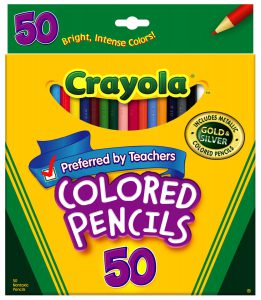 Artist supply company Crayola, which recently celebrated its 130th anniversary, is struggling to get impressionable teens to stop using its colored pencils as DIY eyeliner.
Artist supply company Crayola, which recently celebrated its 130th anniversary, is struggling to get impressionable teens to stop using its colored pencils as DIY eyeliner.
The trend is yet another example of the “P2P pressure” potential of YouTube. Amateur teen beauticians have posted numerous videos showing how they use cups of hot water to soften the “lead” in the colored pencils and then apply it to their eyelids and lips. At least one of the videos already has over 1.3 million views.
The young woman who appears in that particular video assures her viewers that “colored pencils are safe to use on your face, your skin, because [they’re] non-toxic. Companies literally make them so that little kids can eat them and be fine.” She then calls a Crayola customer hotline and asks what would happen if a little kid got their product on his skin or his eye. The woman on the other end of the line reassures her that “all of our products are non-toxic.”
But there is a big difference between “non-toxic” (meaning that your crayon-scarfing 2-year-old will survive) and “FDA-approved,” which is the standard to which all cosmetics are held. The Food and Drug Administration has stringent rules regarding the labeling of cosmetics and the testing that is required to ensure consumer safety, and Crayola colored pencils do not (and are not intended to) meet those requirements. As Crayola itself says:
As the manufacturer of children’s products, safety is our top priority at Crayola. Although our products are nontoxic, we do not recommend using them to make lipstick, eyeliner or other make-up and strongly discourage their use in this manner. They are not designed, tested or approved for this purpose.
Even with properly tested eyeliner, there are concerns that “particle migration” can cause blurred vision or even infection, particularly for those children who wear contact lenses. The potential for problems is undoubtedly greater with untested colored pencils.
According to the Web site eHow, the “lead” in colored pencils is a mixture of five ingredients: extenders (fillers), binders, pigments, wax and water. Extenders are substances like kaolin (a soft white clay), talc, and chalk. The binders are typically cellulose ether and/or vegetable gums. The pigments provide color (again, all untested for cosmetic use), while water and wax help bind everything together.
While it is sometimes hard to figure out what your kids are doing online, this particular cybertrap is a little easier to detect. If your young teen suddenly starts sporting “Pine Green” or “Spiro Disco Ball” eyeshadow, then you can reasonably guess she’s been watching YouTube lately. But try to talk with her (or him) before then; better that your child should get cosmetic advice from you (and the FDA) then some random stranger with a cell phone.